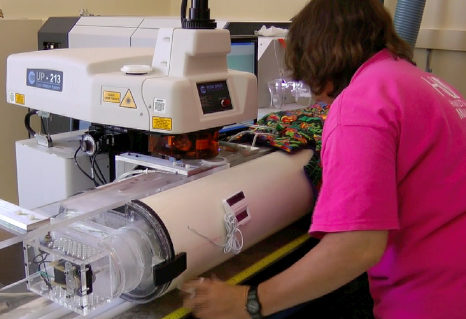Core Meltdown: Blog Seven
Click here to see all Climate Change blog entries.
With the ice cores safely on their way back to Maine, we are making the necessary preparations for their processing and analysis. The extraction of ice from the glaciers is only part of the story; the next chapter begins in the freezer at UMaine’s Climate Change Institute, where the ice will be divided into multiple sections. Each section is designated for a different type of analysis. At CCI we will literally be counting atoms, focusing on the stable isotopes of water and a suite of trace elements.

Stable water isotopes, which include oxygen isotopes (16O and 18O) and hydrogen isotopes (H and 2H), can give us information about changes in temperature and moisture sources at Tupungatito glacier. The stable isotopes will show us annual temperature changes (e.g. winter/summer) as well as long-term variations in regional temperature. We will collect isotope samples at 3-centimenter increments throughout the approximately 60-meter ice core, giving us roughly 2,000 samples. Trace element analysis involves determining the concentration of numerous elements including aluminum, iron, calcium, sodium, sulfur, copper, zinc and lead, to name a few. These different elements can reveal regional environmental changes such atmospheric dust concentrations, marine air-masses (e.g. sea-salts), volcanic emissions and human pollutants. The trace element samples will be run on an Inductively Coupled Plasma Mass Spectrometry (ICP-MS) instrument designed to discern concentrations as low as parts per quadrillion. In addition CCI has developed an in situ laser ablation system that does not require the ice to be melted. The laser ablates the ice surface and the subsequent gas is immediately analyzed by the ICP-MS instrument. Remarkably, the laser system allows a one-meter section of ice core to yield around 100,000 continuous samples compared to about 100 samples if melted — a 1,000-fold increase! This increase in sample resolution is particularly valuable in the deeper sections of the ice core where ice is more compressed and annual layers are much thinner. Sections of the ice will also be sent to our scientific collaborators for analysis of black carbon (an indicator of biomass burning and human pollutants) and for biological samples (CECS will be looking at the bacteria that live on glaciers and how they have changed over time).
As analyses are completed, the data collected will help to uncover how local climate features such as temperature, precipitation, storms and atmospheric chemistry have changed over time at the site and surrounding region. We will be able to add and compare it to other regional-global scale climate records CCI has collected over the years. Each new climate record adds another piece of the puzzle to how and why our planet’s climate has varied in the past and can help give us context necessary to know how it may change in the future. All of us feel very privileged to be a part of this endeavor of discovery, whether it be finding answers or raising new questions.
On a personal note, there is a downside to the exciting expedition lifestyle, which is the stress that it can cause on family life. Working in a remote location where we cannot leave immediately if an emergency were to arise at home or the chance of one of us becoming injured in the field are stress-inducing possibilities. We always make safety a priority and luckily, no one on our expedition was injured in the in 2008 earthquake. We can all agree that it is great to be back home with our families and the time away allows us to truly appreciate those people in our lives that we care about. On lighter note, working and living in the field for long periods of time gives one perspective on the amazing amenities of modern life we take for granted everyday, such as hot water, toilets and deodorant.
We would again like to thank Garrand for their support in making this expedition possible.
